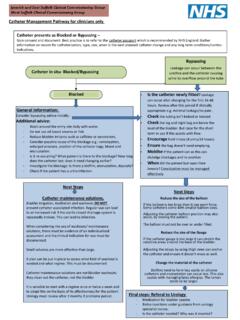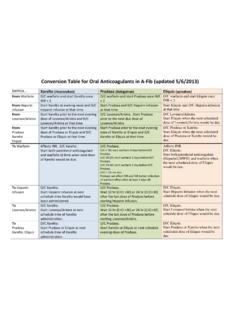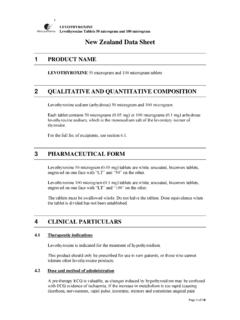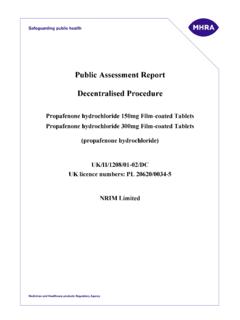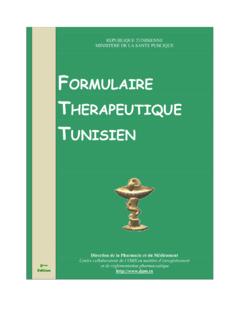Transcription of Dabigatran, rivaroxaban and apixaban, the new oral ...
1 Second Edition November 2013 Page 1 of 32 dabigatran , rivaroxaban and apixaban , the new oral anticoagulants (NOACS), for the prevention of stroke and systemic embolism in nonvalvular atrial fibrillation Implementation of NICE TA 249, 256, and 275 References to warfarin in this document also relate to other vitamin K analogues, acenocoumarol and phenindione The licensed information in this guideline is based on the following Summaries of Product Characteristics: Pradaxa ( dabigatran ) 150mg hard capsules (Boehringer Ingelheim); date of review 08/2013 Xarelto ( rivaroxaban ) 20mg film-coated tablets (Bayer); date of review 06/2013 Eliquis ( apixaban ) 5mg film-coated tablets (Bristol-Myers Squibb); date of review 19/09/2013 This guideline will be reviewed annually; it is the responsibility of the prescriber to consult the most up-to-date prescribing information before prescribing a NOAC.
2 Current Summaries of Product Characteristics can be accessed via the electronic Medicines Compendium (eMC) Contents 1. Introduction page 2 2. Definition of abbreviations and authors/contributors page 2 3. Initiation of a NOAC page 3 4. Conversion from warfarin to a NOAC page 6 5. Disadvantages and advantages of NOACs compared to warfarin page 9 6. GP responsibilities when: a) Initiating a NOAC page 18 b) Converting from warfarin to a NOAC page 18 c) Referring patient to a hospital specialist for possible initiation of a NOAC or for conversion from warfarin to a NOAC page 18 d) Prescribing a NOAC as on-going treatment page 19 7.
3 Appendices Appendix 1: Calculation of CHADS2 and CHA2DS2-VASc scores for stroke risk assessment page 20 Appendix 2: Calculation of HAS-BLED score for bleeding risk assessment page 21 Appendix 3: Patient counselling and alert cards page 22 Appendix 4: Checklists for GP referral to hospital specialist for possible: a) Initiation of a NOAC page 26 b) Conversion from warfarin to a NOAC page 28 Appendix 5: Further information from RE-LY, ROCKET AF, and ARISTOTLE clinical trials page 30 Second Edition November 2013 Page 2 of 32 1. Introduction This guideline has been produced to help identify those patients who are most likely to benefit from dabigatran , rivaroxaban or apixaban , and to provide advice on using these new drugs in the safest possible manner.
4 The guideline covers both newly identified AF patients and existing AF patients currently taking warfarin. It does not and should not over-ride the NICE Technology Appraisals 249, 256 and 275; a clinician may initiate dabigatran , rivaroxaban or apixaban for any patient within the Technology Appraisals (TAs) criteria. The guideline includes the expert advice and opinions of local clinicians following a detailed review of the NOAC clinical trial papers: RE-LY, ROCKET AF, and ARISTOTLE (see Appendix 5, ). For the purposes of this guideline, non-valvular atrial fibrillation is defined as rhythm disturbance occurring in the absence of rheumatic mitral stenosis or a prosthetic heart valve.
5 ACC/AHA/ESC Guidelines for the Management of Patients with Atrial Fibrillation. Circulation 2001;104:2118-2150 2. Definition of abbreviations and authors/contributors Abbreviation Definition AF Atrial fibrillation CHADS2 Stroke risk assessment: Cardiac failure, Hypertension, Age, Diabetes, Stroke (doubled) CHA2DS2-VASc Extended stroke risk assessment: Congestive heart failure, Hypertension, Age 75 (doubled), Diabetes, Stroke (doubled), Vascular disease, Age 65-74, Sex category (female) eGFR Estimated glomerular filtration rate [mL/ ] (taken to be approximately 10mL/minute greater than the calculated creatinine clearance to provide a safety margin).
6 Degrees of renal impairment are detailed in section 6 of this guideline (see ) FBC Full blood count GI Gastro-intestinal HAS-BLED Bleeding risk assessment: Hypertension, Abnormal renal/liver function, Stroke, Bleeding, Labile INR, Elderly, Drugs/alcohol LFTs Liver function tests NOAC New oral anticoagulant ( dabigatran , rivaroxaban , or apixaban ) SPC Summary of Product Characteristics TTR Time in therapeutic range U&Es Urea and electrolytes WSCCG NHS West Suffolk Clinical Commissioning Group Authors Linda Lord Head of Medicines Management, WSCCG Emma Harris Medicines Management Pharmacist, WSCCG Contributors Dr Abul Azim Consultant in Elderly Medicine and Stroke, West Suffolk Hospital Dr P Badrinath Consultant in Public Health Medicine, Suffolk County Council Dr Christopher Browning GP Prescribing Lead, WSCCG Dr Dipti Chitnavis Consultant in Haematology.
7 West Suffolk Hospital Dr Emma Derbyshire GP Prescribing Lead, WSCCG Dr Claire Hughes Consultant in Haematology, West Suffolk Hospital Dr Zarif Jabbar-Lopez FY2 Doctor in Public Health Medicine, Suffolk County Council Katie Johnson Speciality Registrar in Public Health Medicine, Suffolk County Council Dr Shubhada Sinha Clinical Director for Acute Medicine, West Suffolk Hospital Simon Whitworth Chief Pharmacist, West Suffolk Hospital The WSCCG would like to thank the NHS Northamptonshire Prescribing Advisory Group and the East of England Priorities Advisory Committee for sharing their papers on dabigatran and rivaroxaban .
8 Second Edition November 2013 Page 3 of 32 3. Initiation of a NOAC Applies to newly diagnosed AF patients and to existing AF patients who are not able to take warfarin. oral anticoagulation is indicated for patients with a CHADS2 or a CHA2DS2-VASc score 2 (see Appendix 1, ) Warfarin remains a suitable first-line oral anticoagulant for most patients Warfarin is the preferred option in patients with: eGFR <40 Patients with a baseline eGFR of 40-50 are at risk of progressive/acute renal dysfunction and the potential risks of bleeding with a NOAC should be weighed on an individual basis a history of significant peptic ulcer disease significant ischaemic heart disease Physicians should be extraordinarily conservative in considering whether NOACs are appropriate replacements for warfarin.
9 Strict adherence to prescribing guidelines and a vigilant eye on medication safety literature should guide the management of individual patients receiving newly approved medications with potential life-threatening side effects. A NOAC can be offered as an alternative option to warfarin for the prevention of stroke and systemic embolism provided that NICE criteria are satisfied (see Table 1a below). Further recommendations are provided in Table 2a ( ) to help identify those patients who are most likely to benefit from a NOAC, and to provide advice on using the NOACs in the safest possible manner.
10 Table 1a NICE criteria to be met when initiating a NOAC for the prevention of stroke and systemic embolism in AF dabigatran is an option if: rivaroxaban is an option if: apixaban is an option if: Nonvalvular AF and NICE TA 249 criteria are satisfied, one or more of the following risk factors: Previous stroke, TIA or systemic embolism Left ventricular ejection fraction below 40% Symptomatic heart failure of New York Heart Association class 2 or above Age 75 years or older Age 65 years or older with one of the following: diabetes mellitus, coronary artery disease or hypertension Nonvalvular AF and NICE TA 256 criteria are satisfied, one or more risk factors such as: Congestive heart failure Hypertension Age 75 years or older Diabetes mellitus Prior stroke or TIA Nonvalvular AF and NICE TA 275 criteria are satisfied, one or more risk factors such as: Prior stroke or TIA Age 75 years or older Hypertension Diabetes mellitus Symptomatic heart failure NICE TAG 249 ( dabigatran ): NICE TAG 256 ( rivaroxaban ): NICE TAG 275 ( apixaban ).






